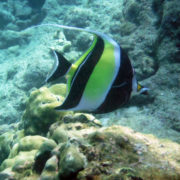Ocean Warming Dooms Most Fish
The oceans could look much emptier by 2100, according to a new study that found that most fish species would not be able to survive in their current habitat if average global temperatures rise 4.5 degrees Celsius by the end of the century, The Guardian reported earlier this week.
The researchers of the new paper said that 60 percent of fish species face a grave threat from global heating if temperatures approach that worst-case scenario level. The species under threat include many common fish found in grocery stores, including staples like Atlantic cod, Alaska pollock and sockeye salmon, and sport fishing favorites like swordfish, barracuda and brown trout, as CNN reported.
The new study, published in the journal Science, looked at how nearly 700 fresh and saltwater fish species respond to warming ocean temperatures.
The problem for most fish is that as ocean temperatures rise, the oxygen level goes down, which makes it extremely challenging for embryos to survive.
“A 1.5C increase is already a challenge to some, and if we let global warming persist, it can get much worse,” said Hans-Otto Pörtner, a co-author on the paper and a climatologist at the Alfred Wegener Institute, Helmholtz Centre for Polar and Marine Research in Germany.
That 1.5 degrees Celsius threshold would result in 10 percent of marine species suffering over the next 80 years, including the aforementioned grocery staples.
However, even a 10 percent decline in fish species has a large ripple effect on ecosystems as one species being pushed out effects the food supply and the habits of many other species that have evolved to be interdependent.
Since we are already 1 degree warmer than the pre-industrial level and emissions are starting to rise around the world as countries reopen, it seems highly unlikely that the world will not blow past that lowest benchmark. In fact, we are currently on pace for a 3 degree increase over the pre-industrial level, as The Guardian noted.
“More than half of the species potentially at risk is quite astonishing, so we really emphasize that it’s important to take action and follow the political commitments to reduce climate change and protect marine habitats,” said Dr. Flemming Dahlke, a marine biologist at Germany’s Alfred Wegener Institute and one of the authors of the study, as CNN reported.
“Some species might successfully manage this change,” said Dahlke, as the Daily Mail reported. “But if you consider the fact that fish have adapted their mating patterns to specific habitats over extremely long time frames, and have tailored their mating cycles to specific ocean currents and available food sources, it has to be assumed that being forced to abandon their normal spawning areas will mean major problems for them.”
A lot of this is a conservative estimate since the study did not take into account pollution or the increased acidity of the ocean, which could present additional challenges to sensitive species, as The Guardian noted.
“Some tropical fish are already living in zones at their uppermost tolerance, their areas are already 40C,” Pörtner said. “Humankind is pushing the planet outside of a comfortable temperature range and we are starting to lose suitable habitat. It’s worth investing in the 1.5C goal.”
https://science.sciencemag.org/content/369/6499/65
Scientific report source abstract – the journal, Science – originally published 07-03-20
Species’ vulnerability to climate change depends on the most temperature-sensitive life stages, but for major animal groups such as fish, life cycle bottlenecks are often not clearly defined. We used observational, experimental, and phylogenetic data to assess stage-specific thermal tolerance metrics for 694 marine and freshwater fish species from all climate zones.
Our analysis shows that spawning adults and embryos consistently have narrower tolerance ranges than larvae and nonreproductive adults and are most vulnerable to climate warming. The sequence of stage-specific thermal tolerance corresponds with the oxygen-limitation hypothesis, suggesting a mechanistic link between ontogenetic changes in cardiorespiratory (aerobic) capacity and tolerance to temperature extremes.
A logarithmic inverse correlation between the temperature dependence of physiological rates (development and oxygen consumption) and thermal tolerance range is proposed to reflect a fundamental, energetic trade-off in thermal adaptation. Scenario-based climate projections considering the most critical life stages (spawners and embryos) clearly identify the temperature requirements for reproduction as a critical bottleneck in the life cycle of fish.
By 2100, depending on the Shared Socioeconomic Pathway (SSP) scenario followed, the percentages of species potentially affected by water temperatures exceeding their tolerance limit for reproduction range from ~10% (SSP 1–1.9) to ~60% (SSP 5–8.5). Efforts to meet ambitious climate targets (SSP 1–1.9) could therefore benefit many fish species and people who depend on healthy fish stocks.




Leave a Reply
Join the Community discussion now - your email address will not be published, remains secure and confidential. Mahalo.